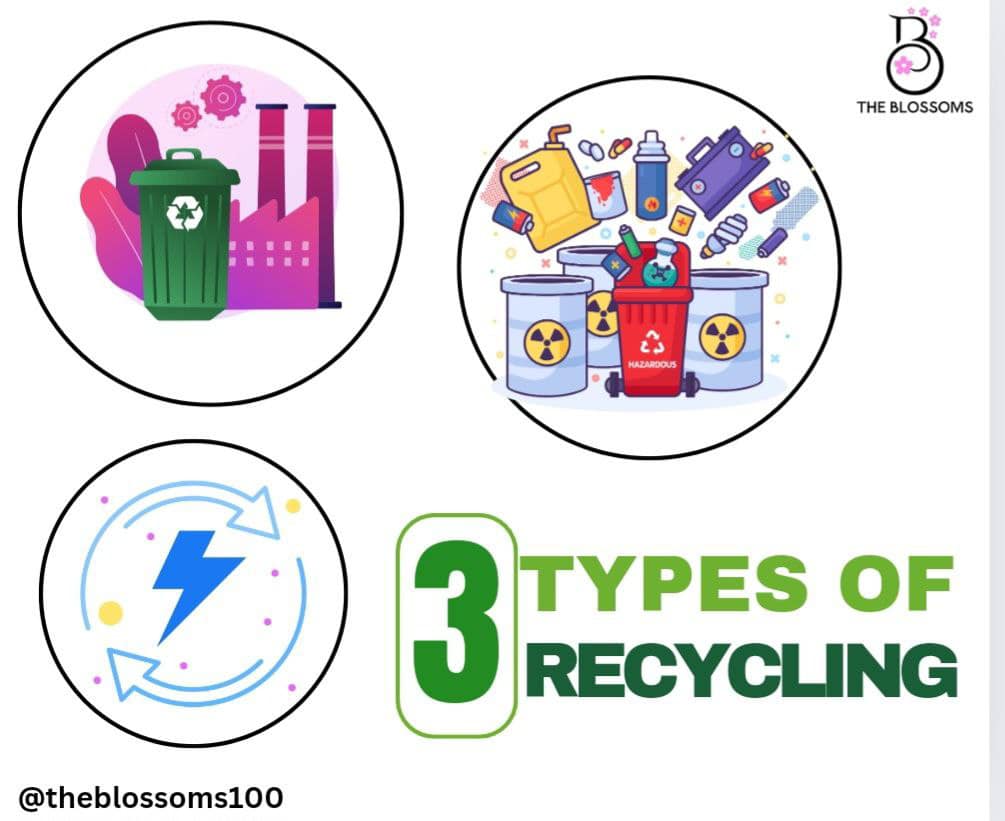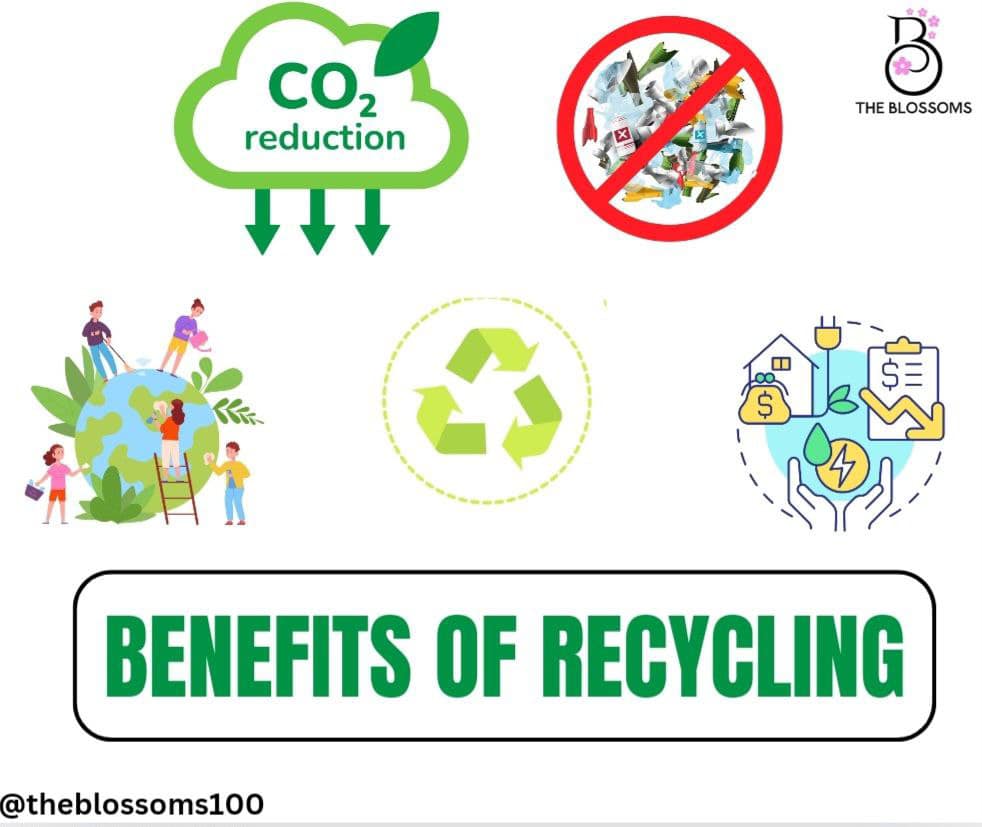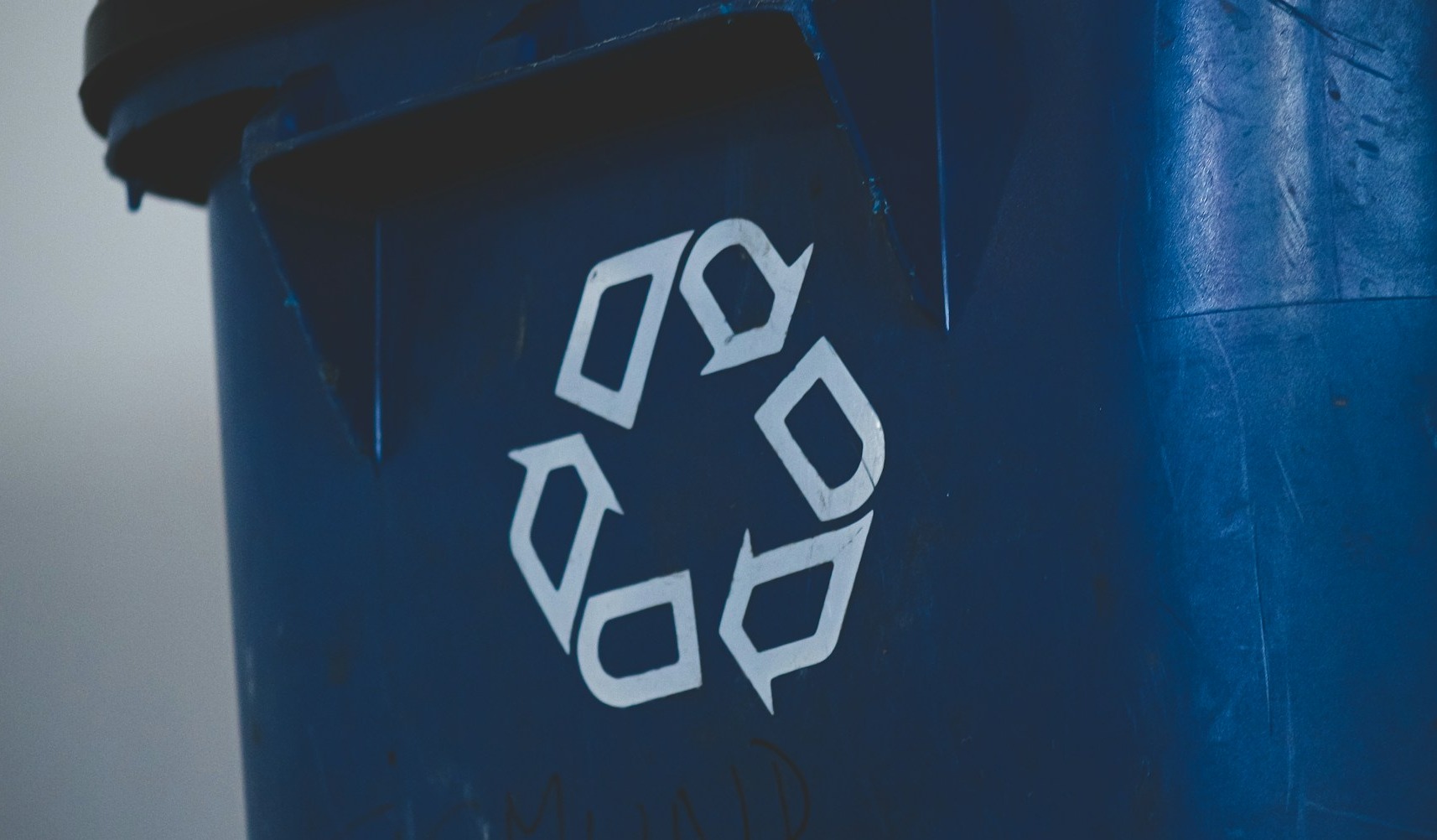Recycling ဆိုတာ အသုံးပြုပြီးသား ပစ္စည်းတွေကို ပစ္စည်း အသစ်ပြန်လည်ထုတ်လုပ်ပြီး အသုံးပြုခြင်း ဖြစ်ပါတယ်။နောက်ပြီး အသုံးမလိုတော့တဲ့ စွန့်ပစ်ပစ္စည်းတွေကို ပြန်လည်ထုတ်လုပ်ပြီး ပစ္စည်းအသစ်အနေနဲ့ ထပ်မံအသုံးပြုတာကလည်း recycling လုပ်ငန်းစဉ်ထဲမှာ ပါဝင်ပါတယ်။
Recycle လုပ်ခြင်းကြောင့် ပတ်ဝန်းကျင်အတွက် ကောင်းမွန်သော အကျိုးသက်ရောက်မှုတွေက
1. သဘာဝအရင်းအမြစ်တွေကို ထိန်းသိမ်းကာကွယ်ရာရောက်ခြင်း
2. ဖို့မြေတွင်စုပုံလာမည့် အမှိုက်သရိုက်များလျော့နည်းလာခြင်း
3. စွမ်းအင်နှင့် ငွေကုန်ကြေးကျ သက်သာခြင်း
4. အလုပ်အကိုင်အခွင့်အလမ်းများ ဖန်တီးပေးနိုင်ခြင်း
5. Greenhouse Gas ထုတ်လွှတ်မှု လျှော့ချပေးနိုင်ခြင်း
Recycling လုပ်တဲ့အခါမှာ တူညီတဲ့ ထုတ်လုပ်မှု ပုံစံအတိုင်း စွန့်ပစ်ပစ္စည်းတွေကို ပြန်လည်အသုံးပြုခြင်း (ဒါမှမဟုတ်) အသုံးပြုပြီးသား ပစ္စည်းတွေကနေ အသုံးဝင်တဲ့ ပစ္စည်းတွေကို ပြန်လည် ထုတ်လုပ်ခြင်း စသဖြင့် နည်းလမ်းနှစ်မျိုးရှိပါတယ်။အသုံးများတဲ့ ပြန်လည်ထုတ်လုပ်အသုံးပြုလို့ရတဲ့ ပစ္စည်းတွေက သတ္တုတွေ၊ စက္ကူ၊ ဖန်သား၊ ပလတ်စတစ်၊ ရာဘာ၊ ဇီဝစွန့်ပစ်ပစ္စည်းများ နှင့် ဆောက်လုပ်ရေးသုံး စွန့်ပစ်ပစ္စည်းတွေ ဖြစ်ပါတယ်။
Recycling လုပ်တဲ့အခါ အောင်မြင်မှုရှိမရှိကို ပြည်တွင်း recycler တွေရဲ့ recycle လုပ်မယ့်ပစ္စည်းအပေါ် လက်ခံနိုင်မှုအနေအထား၊ ယင်းပစ္စည်းတွေကို သန့်ရှင်းစွာ ထိန်းသိမ်းခြင်း၊ လွယ်ကူတဲ့ ထုတ်ကုန်တစ်ခုဖြစ်လာရန် ရွေးချယ်ခြင်း စတဲ့အချက်တွေပေါ်မှာ မူတည်ပါတယ်။အချုပ်အားဖြင့်ဆိုရင် recycling လုပ်ခြင်းဟာ စွန့်ပစ်ပစ္စည်းတွေ လျော့နည်းလာမှု နှင့် သဘာဝ ပတ်ဝန်းကျင်ကို အကျိုးပြုနိုင်မှု အတွက် အရမ်းကို အရေးပါလှပါတယ်။
✨Recycling အမျိုးအစားများ
Recycling အမျိုးအစား သုံးမျိုးရှိပါတယ်။

1. Mechanical Recycling
Mechanical Recycling ဟာ တစ်ကမ္ဘာလုံး အတိုင်းအတာအရ အသုံးအများဆုံး နည်းလမ်းတစ်ခုဖြစ်ပါတယ်။ထိုနည်းလမ်းဟာ recycle လုပ်လို့ရတဲ့ ပစ္စည်းတွေရဲ့ မော်လီကျူးပုံစံကို ပြုပြင် ပြောင်းလဲခြင်းမရှိဘဲ ထုတ်လုပ်တဲ့ နည်းလမ်းဖြစ်ပါတယ်။Mechanical Recycling မှာ ကြိတ်ခြေခြင်း၊ သန့်စင်ခြင်း၊ သီးခြားကန့်ထားခြင်း၊ အခြောက်ခံခြင်း၊ သေးငယ်သော အရာလေးများဖြစ်အောင်ပြုလုပ်ခြင်း၊ ပလတ်စတစ်စွန့်ပစ်ပစ္စည်းများကို ယခင်ထုတ်ကုန်အတိုင်း တူညီစွာအသုံးပြုနိုင်ရန် ပြန်လည်ထုတ်လုပ်ခြင်း နှင့် ယခင်ထုတ်ကုန်ထက် အရည်အသွေး နိမ့်ကျသော ပစ္စည်းများပြုလုပ်ခြင်း ဆိုတဲ့ လုပ်ငန်းစဉ်တွေရှိပါတယ်။
2. Chemical Recycling
Chemical recycling လုပ်ငန်းစဉ်မှာ အသုံးပြုပြီးသော ပစ္စည်းတွေရဲ့ မော်လီကျူးတွေကို pyrolysis နည်းပညာဖြင့်လည်းကောင်း၊ gasification နှင့် depolymerization နည်းပညာဖြင့်လည်းကောင်း ဖြိုခွဲခြင်း၊ recycle ပြုလုပ်သော ပစ္စည်းတွေရဲ့ နဂို မူလ အရည်အသွေး မပျောက်ပျက်အောင် ပြုလုပ်ခြင်း တို့ပါဝင်ပါတယ်။ဒီနည်းလမ်းကိုတော့ ကမ္ဘာအနှံ့ ကျယ်ကျယ်ပြန့်ပြန့် အသုံးမပြုကြသေးပါဘူး။
3. Energy Recycling
Energy recycling ဟာ ပလတ်စတစ်တွေကို မီးရှို့ပြီး အပူနှင့် လျှပ်စစ် စွမ်းအင်အဖြစ် ပြောင်းလဲတာကို ဆိုလိုခြင်းဖြစ်ပါတယ်။ထိုနည်းလမ်းဟာ ဖို့မြေနေရာတွေကို လျော့နည်းစေပေမယ့် ကြီးမားတဲ့ ရင်းနှီးမြုပ်နှံမှု နဲ့ အာဏာပိုင်တွေဆီက သဘောတူညီမှုတွေ ရရှိဖို့ရန် လိုအပ်ပါတယ်။နောက်ပြီး သဘာဝပတ်ဝန်းကျင်နှင့် ပိုပြီး သဟဇာတ ဖြစ်မယ့် ထုတ်လွှတ်မှုတွေအတွက် ခေတ်မှီ စက်ကိရိယာတွေကိုလည်း လိုအပ်ပါတယ်။
✨Process of Recycling
Recycling process တွေဟာ recycle လုပ်မယ့် ပစ္စည်းအပေါ်မှာ မူတည်ပေမယ့်လည်း ယေဘူယျအားဖြင့် ဒီအချက်တွေ ပါဝင်ပါတယ်။
1. Collection and Sorting
ပထမဆုံးအဆင့်အနေနှင့် စွန့်ပစ်ပစ္စည်းတွေစီမံခန့်ခွဲမှုအပေါ်အခြေပြုပြီး recycle လုပ်လို့ရတဲ့ပစ္စည်းတွေ ထားရှိရာနေရာတွေကနေသော်လည်းကောင်း၊ အသုံးမလိုတော့သောပစ္စည်းများ၊ လှူဒါန်းရန်အတွက် ထားရှိသော ပစ္စည်းများ ယူသွားနိုင်သော နေရာများကနေသော်လည်းကောင်း၊ recycle လုပ်လို့ရသော ပစ္စည်းများဝယ်ယူရာနေရာများကနေသော်လည်းကောင်း ပစ္စည်းများကိုစုဆောင်းပြီး သင့်တော်သော ပစ္စည်းများထုတ်လုပ်ရန် အမျိုးအစားအလိုက် လူအားဖြင့်လည်းကောင်း၊ auto စက်များဖြင့်လည်းကောင်း ခွဲခြားထားခြင်း။
2. Cleaning and Processing
အမျိုးအစားခွဲခြားပြီးတာနှင့်တစ်ပြိုင်နက် ပစ္စည်းတွေကို အဆိပ်အတောက်တွေ၊ ရောဂါပိုးမွှားတွေမပါအောင် သန့်ရှင်းပါတယ် (ဥပမာအနေဖြင့် ပလတ်စတစ် ဘူးတွေ၊ ပုလင်းတွေကို အကြွင်းအကျန်၊ အညစ်အကြေးများ ဖယ်ရှားရန်ဆေးကြောခြင်း)။ နောက်ပြီး သန့်စင်ပြီးသား ပစ္စည်းများကို ပြန်လည်အသုံးပြုနိုင်သော ပုံစံ အနေအထား ရောက်အောင် လုပ်ဆောင်ပါတယ်။ဒီ processing လုပ်ငန်းမှာဆိုရင်တော့ အစိတ်စိတ်အမွှာမွှာဖြစ်အောင် ခြေမွခြင်း၊ အရည်ပျော်ခြင်း၊ အမျှင်များဖြစ်လာအောင် ဖြိုခွဲခြင်း စတဲ့ နည်းလမ်းတွေပါဝင်ပါတယ်။
အဲလို လုပ်ဆောင်ပြီးသွားတဲ့ ပစ္စည်းအစိတ်အပိုင်းတွေကို ထုတ်ကုန်အသစ်တစ်ခုအနေနှင့် ပြန်လည်ထုတ်လုပ်ပါတယ်။ဥပမာအနေနှင့်
1…ဖြိုခွဲပြီးသား စက္ကူအမျှင်စများကို နောက်ထပ် စက္ကူနှင့်ပတ်သက်သော ထုတ်ကုန်အသစ်ပြုလုပ်ခြင်း
2… ပလတ်စတစ်များကို အရည်ပျော်စေ၍ အလုံးပုံသဏ္ဌာန် သို့မဟုတ် အမျှင်ပုံစံများဖြစ်အောင် ပုံစံပြောင်းပြီး ပလတ်စတစ်နှင့်ဆိုင်သော ထုတ်ကုန်အသစ်များပြုလုပ်ခြင်း
3…ဖန်စများကို ပုံစံပြောင်း၍ ဖန်ပုလင်းများ၊ ကရားများအဖြစ် ပြုလုပ်ခြင်း
4…သတ္တုများကို အရည်ပျော်စေပြီး ပုံစံပြောင်း၍ ပုံစံအသစ် ထုတ်လုပ်ခြင်း
3. Purchasing Recycled Products
နောက်ဆုံး အဆင့်အနေနှင့် Recycled လုပ်ထားတဲ့ ထုတ်ကုန်အသစ်တွေကို ဝယ်ယူသူတွေထံေရာင်းချခြင်းပဲဖြစ်ပါတယ်။ဒီလိုမျိုးပြုလုပ်ခြင်းဟာ Recycle လုပ်ထားတဲ့ ပစ္စည်းများအတွက် ဈေးကွက်တစ်ခုဖော်ဆောင်ပေးပြီး Recycling လုပ်ငန်းတစ်ခုလုံးကို အားပေးမြှင့်တင်ရာ ရောက်ပါတယ်။
Recycling လုပ်ငန်းစဉ်တွေဟာ Recycle လုပ်မယ့်ပစ္စည်းတွေအပေါ် မူတည်ပြီး အနည်းငယ်မျှသာ ကွာခြားမှုရှိပါတယ်။ပုံမှန်အားဖြင့်အနေနှင့်ကတော့လုပ်ဆောင်ရတဲ့ အဆင့်တွေက အတူတူပါပဲ။ထုတ်လုပ်မယ့်ပစ္စည်းပေါ်မူတည်ပြီး သေသေချာချာ အမျိုးအစားခွဲပြီး အညစ်အေကြးတွေ၊ အဆိပ်အတောက်ဖြစ်စေမယ့် အရာတွေကို ဖယ်ရှားခြင်းက အရည်အသွေးကောင်းမွန်တဲ့ ထုတ်ကုန်တစ်ခုကို ပြန်လည် ထုတ်လုပ်တဲ့အခါမှာ အခြေခံအကျဆုံး အချက်တစ်ချက်ဖြစ်ပါတယ်။
✨Environment Impact on Recycling
Recycling လုပ်ခြင်းဟာ သဘာဝပတ်ဝန်းကျင်အတွက် ကောင်းမွန်တဲ့ အကျိုးသက်ရောက်မှုများစွာရှိပါတယ်။
1. စွန့်ပစ်ပစ္စည်းများအတွက်ဖို့မြေ အသုံးပြုမှုလျော့နည်းလာခြင်း
Recycling လုပ်ခြင်းဟာ ဖို့မြေတွေအပေါ်မှာ စုပုံလာမယ့် စွန့်ပစ်ပစ္စည်း ပမာဏကို လျှော့ချပေးပါတယ်။ထို့အတွက်ကြောင့် ယင်းမြေရဲ့ သက်တမ်းကို ကြာရှည်ခံစေပြီး နောက်ထပ်စွန့်ပစ်ပစ္စည်းများစုပုံရာ မြေ နေရာလိုအပ်မှု ကို လျှော့ချပေးပါတယ်။
2. သဘာဝအရင်းအမြစ်များ ထိန်းသိမ်းကာကွယ်ရာရောက်ခြင်း
Recycle လုပ်မည့်ပစ္စည်းများသည် ထုတ်ကုန်အသစ်ပြုလုပ်ရန် ကုန်ကြမ်းအနေဖြင့် အသုံးပြုရသောကြောင့် ကျွန်းသစ်၊ ရေ နှင့် သတ္တုဓာတ် ကဲ့သို့သော သဘာဝ အရင်းအမြစ်များသုံးစွဲမှုကို လျော့နည်းစေခြင်းဖြင့် သဘာဝပတ်ဝန်းကျင်ကို ထိန်းသိမ်းကာကွယ်ပေးပါတယ်။
Paper Recycling လုပ်ခြင်းဖြင့် စက္ကူတန်ချိန် တစ်တန်ဟာ သစ်ပင် 17ပင်ကို ကာကွယ်ထိန်းသိမ်းပေးခြင်းနှင့် ညီမျှပါတယ်။
3. စွမ်းအင် အသုံးပြုမှု လျော့နည်းစေခြင်း
Recycling လုပ်ခြင်းဟာ ကုန်ကြမ်းအသစ်တွေကနေ ပစ္စည်းအသစ်ထုတ်လုပ်ရတာထက် စွမ်းအင်သုံးစွဲမှု လျော့နည်းပါတယ်။ဥပမာအားဖြင့် aluminium ကို recycle လုပ်၍ပြန်လည်သုံးစွဲခြင်းဟာ သတ္တုရိုင်းတွေကနေ aluminium ထုတ်လုပ်ရန် လိုအပ်သော စွမ်းအင် 95%ကို ကာကွယ်ပေးပါတယ်။
4. ကာဗွန်ပမာဏလျှော့ချပေးခြင်း
Recycling လုပ်ခြင်းဟာ စွမ်းအင်သုံးစွဲမှု လျော့နည်းစေတဲ့အတွက်ကြောင့် Greenhouse Gas နှင့် Carbon Dioxide ထုတ်လွှတ်မှုကိုပါ လျှော့ချပေးပြီး ရာသီဥတုပြောင်းလဲမှုကို လျှော့ချပေးပါတယ်။
5. ညစ်ညမ်းမှု လျှော့ချပေးခြင်း
Recycle ပြုလုပ်ခြင်းဟာ ထုတ်ကုန်အသစ်တွေပြုလုပ်ရန် သဘာဝပတ်ဝန်းကျင် ထိခိုက်စေသော လုပ်ငန်းများပါဝင်တဲ့ လိုအပ်သော ကုန်ကြမ်းများထုတ်ယူခြင်းကို လျော့နည်းစေတဲ့အတွက်ကြောင့် သဘာဝပတ်ဝန်းကျင် ညစ်ညမ်းမှုကို လျော့နည်းစေပါတယ်။မီးရှို့ဖျက်ဆီးရန်လိုအပ်သော စွန့်ပစ်ပစ္စည်းများကို recycle ပြုလုပ်ခြင်းဖြင့် လေ နှင့် ရေ ညစ်ညမ်းမှုကိုပါ လျှော့ချပေးပါတယ်။
✨Recycling လုပ်ငန်းစဉ်မှာ တွေ့ကြုံရတဲ့ အခက်အခဲများ
Recycling လုပ်ခြင်းဟာ သဘာဝပတ်ဝန်းကျင် အတွက်ဆိုးကျိုးတွေဖြစ်ပေါ်မှုကို လျှော့ချပေးနိုင်တဲ့ သိသာထင်ရှားတဲ့ဖြေရှင်းချက်တစ်ခုလို့ ထင်ရပေမယ့် ကမ္ဘာနဲ့ချီရင် အကန့်အသတ်တွေရှိနေပါသေးတယ်။ကြုံတွေ့ရနိုင်တဲ့ အခက်အခဲတစ်ချို့ကတော့
1. အသိပညာအားနည်းမှုကြောင့် recycling လုပ်ရာမှာ ထုတ်ကုန်အရည်အသွေးနိမ့်ကျခြင်း
ယနေ့အခါမှာ လူအများစုက recycling လုပ်ခြင်းကြောင့် သဘာဝပတ်ဝန်းကျင်ကို အကျိုးပြုမှုနဲ့ပတ်သက်ပြီး လုံလောက်တဲ့ အသိပညာတွေရှိလာကြပါပြီ။သို့ရာတွင် ကျွန်တော်တို့ဟာ ဘယ်လိုအရာတွေကို စွန့်ပစ်ရမယ်၊ ဘယ်လိုအမှိုက်တွေကို recycle လုပ်မယ့်အမှိုက်ပုံးထဲ မစွန့်ပစ်ရဘူးဆိုတာနဲ့ပတ်သက်ပြီး ကွဲကွဲပြားပြား သိဖို့ လိုအပ်နေပါသေးတယ်။ဒီလို သေချာရေရာမှုမရှိခြင်းကြောင့် ဥပမာအနေနှင့်ပြောရရင် recycle ပြုလုပ်၍မရတဲ့ ပလတ်စတစ်အိတ်တွေဟာrecycling ပြုလုပ်၍ရသော ပစ္စည်းတွေနှင့် ရောသွားတဲ့အခါမှာ အဆိပ်အတောက်ဖြစ်စေပြီး အရည်အသွေးကိုလျော့ကျစေတဲ့အပြင် recycle လုပ်တဲ့ စက်ယန္တရားကိုပါ ထိခိုက်စေပါတယ်။နောက်တစ်ချက်က သုံးစွဲသူတွေအနေနှင့် ဘယ်လိုအရာတွေက recycle လုပ်လို့ရတယ် မရဘူးဆိုတာ သေချာနားမလည်ဘဲ အမှိုက်အားလုံးကို စွန့်ပစ်ကြခြင်းပဲဖြစ်ပါတယ်။
2. လုပ်သားများရဲ့ ဘေးအန္တရာယ်လုံခြုံရေး
Recycling လုပ်ငန်းစဉ်ယန္တရား လည်ပတ်နေချိန်မှာ လုပ်ငန်းဆောင်ရွက်သူတွေကြုံတွေ့ရနိုင်တဲ့ ဘေးအန္တရာယ်တွေကတော့
ဓာတုပစ္စည်းများနှင့် ထိတွေ့မှုရှိခြင်း
မီးလောင်လွယ်သော အမှုန့်များကြောင့် ပေါက်ကွဲလွယ်ခြင်း
အန္တရာယ်ရှိသောစက်ပစ္စည်းများစောင့်ကြည့်ရခြင်း
ရွေ့လျားနေသော စက်ပစ္စည်းများနှင့်အတူ အားပြင်းသော ကိရိယာများ ကိုင်တွယ်ရခြင်းကြောင့် အန္တရာယ်ဖြစ်စေနိုင်မှု
စတဲ့ အထက်ပါအကြောင်းအရာတွေကြောင့် လုပ်သားတွေ အလုပ်မှနှုတ်ထွက်မှုနှုန်းက မြင့်မားလျက်ရှိပါတယ်။
3. ကုန်ကျစရိတ်နှင့် ထောက်ပံ့မှုမလုံလောက်ခြင်း
ထိရောက်တဲ့ recycling system တစ်ခုဖြစ်ဖို့အတွက် မြို့တိုင်းမှာ recycle လုပ်လို့ရတဲ့ပစ္စည်းတွေ စွန့်ပစ်ရန် သီးသန့် အမှိုက်ပုံးထားရှိပေးဖို့၊ recycle လုပ်တဲ့ center တွေ ထားရှိပေးဖို့လိုအပ်ပါတယ်။သို့သော်လည်း လုံလောက်တဲ့ အရင်းအနှီး နဲ့ recycling နဲ့ပတ်သက်တဲ့ ဝန်ဆောင်မှုတွေ ထားရှိဖို့ အစိုးရရဲ့ လုံလောက်တဲ့ထောက်ပံ့မှုမရရှိမှုတွေက တစ်ချို့သောမြို့တွေအတွက် ပြဿနာတစ်ခုဖြစ်ပါတယ်။
4. Recycled ပြုလုပ်ထားသော ပစ္စည်းတွေရဲ့ ဝယ်လိုအားနည်းမှု
တစ်ချို့ စီးပွားရေးလုပ်ငန်းရှင်တွေဟာ recycled လုပ်ထားတဲ့ပစ္စည်းများကို second-hand ပစ္စည်းအဟောင်းများကို မူရင်းဈေးအတိုင်းပြန်လည်ဝယ်ယူခြင်းလို့ သတ်မှတ်ကြတယ်။အထူးသဖြင့် Covid-19 ကပ်ရောဂါဖြစ်ပွားတဲ့အချိန်အတွင်းမှာ အသုံးမပြုရသေးသော အသစ်စက်စက် ပလတ်စတစ်တွေက သုံးစွဲပြီးသား plastic တွေထက် ဈေးနှုန်းဟာ အဆများစွာ နည်းပါတယ်။
Non-recyclable ပစ္စည်းတွေဟာ recycle လုပ်တဲ့ ပစ္စည်းတွေနဲ့အတူတူ ရောနှောသွားတဲ့အခါမှာ အရည်အသွေးနိမ့်ကျတဲ့ ထုတ်ကုန်တွေဖြစ်လာရခြင်းကလည်း ဝယ်လိုအားနည်းစေတဲ့ အကြောင်းအရင်းတစ်ရပ်ဖြစ်ပါတယ်။ထိုအတွက်ကြောင့် စွန့်ပစ်ပစ္စည်း စီမံခန့်ခွဲတဲ့ ကုမ္ပဏီတွေအနေနဲ့ ထိုအရာများအတွက် ပိုပြီးကုန်ကျစရိတ်များပြားတဲ့ ကြိုးပမ်းဆောင်ရွက်ချက်တွေကို လုပ်ဆောင်ရသလို recycle လုပ်လို့ရတဲ့ပစ္စည်းတွေအစား ကုန်ကြမ်းအသစ်တွေကို ပိုလိုအပ်လာပါတယ်။ထို့ကဲ့သို့ လိုအပ်လာခြင်းက စွမ်းအင် အသုံးပြုမှုနှင့် Greenhouse Gas ထုတ်လွှတ်မှုကိုပါ ပိုပြီးအရှိန်မြင့်လာစေပါတယ်။
✨Recycle ပြဿနာတွေအတွက် ဖြေရှင်းချက်များ
1. Recycling လုပ်ခြင်းရဲ့အရေးပါမှုကို လူထုကသိရှိအောင် ပညာပေးခြင်း
လူသားတွေက ၎င်းတို့ရဲ့လုပ်ဆောင်ချက်တွေကြောင့် သဘာဝပတ်ဝန်းကျင်အပေါ် ဆိုးကျိုးများစွာဖြစ်ပေါ်နေခြင်းကို သတိပြုမိဖို့ မေ့လျော့နေတဲ့အတွက်ကြောင့် ပိုပီး ကောင်းမွန်တဲ့ ကမ္ဘာကြီးတစ်ခုကိုဖော်ဆောင်ဖို့ recycling လုပ်ခြင်းဟာ ဘယ်လိုမျိုးအရေးပါတယ်ဆိုတာကို လူထုက သိရှိဖို့ အရေးကြီးပါတယ်။ Recycling နဲ့ပတ်သက်ပြီး လေ့လာသင်ယူခြင်းက လူတစ်ဦးချင်းအလိုက် recycling လုပ်ခြင်းက စွန့်ပစ်ပစ္စည်းတွေလျှော့ချဖို့အတွက် ဘာကြောင့်အခြေခံကျတယ်ဆိုတာကို သိရှိနားလည်စေရုံသာမက recycling programs တွေမှာပါ ပါဝင်လာအောင် စည်းရုံးလှုံ့ဆော်ပေးပါတယ်။ဥပမာအနေနှင့် aluminiumပုံးတစ်ခုကို recycle လုပ်ခြင်းက television တစ်ခုကို သုံးနာရီကြာဖွင့်ရန်လိုအပ်သော စွမ်းအင်ပမာဏကို ချွေတာပေးပါတယ်။
2. Social Media ကိုအသုံးပြု၍ လူထုကို ပညာပေးခြင်းနှင့် အသင်းအဖွဲ့အလိုက် လှုပ်ရှားဆောင်ရွက်မှုများ ပြုလုပ်ပေးခြင်း
ယနေ့ခေတ်မှာ လူတော်တော်များများဟာ မတူညီတဲ့ ရည်ရွယ်ချက်တွေနဲ့ facebook, instagram,twitter စတဲ့ social media platform တွေကို အသုံးပြုလာကြပါပြီ။The Blossoms ရဲ့ Environmental Department ရဲ့ ပန်းတိုင်ဖြစ်တဲ့ sustainable living အတွက် လူထုကိုအသိပညာပေးတဲ့ စိတ်ဝင်စားဖို့ကောင်းတဲ့ အကြောင်းအရာတွေကို social media မှာ မျှဝေပေးခြင်းမျိုးက ပြည်သူလူထုဆီ ပိုပြီးကျယ်ကျယ်ပြန့်ပြန့်နဲ့ မြန်မြန်ဆန်ဆန် ရောက်ရှိနိုင်မှာဖြစ်ပါတယ်။ကိုယ်တိုင်ပါဝင်ဆောင်ရွက်လာစေဖို့အတွက် မြှင့်တင်နေတဲ့အချိန်မှာ အသင်းအဖွဲ့အလိုက်လှုပ်ရှားဆောင်ရွက်မှုတွေ ပြုလုပ်ပေးခြင်း၊ ပြိုင်ပွဲတွေကျင်းပပေးခြင်းကလည်း လူထုရဲ့ awareness ကို ပိုပီးရရှိစေမှာဖြစ်ပါတယ်။
✨Recycling လုပ်ဆောင်ရာမှာကြုံတွေ့ရတဲ့ နည်းပညာအခက်အခဲတွေကို ဖြေရှင်းခြင်း
1. ဆန်းသစ်သောနည်းပညာတွေကို အကောင်အထည်ဖော်ဆောင်ရွက်ခြင်း
Recycling လုပ်ဆောင်တဲ့အခါမှာ ညစ်ညမ်းမှုတွေ၊ အဆိပ်အတောက်တွေပါဝင်မှု က အခက်အခဲတစ်ခုဖြစ်တဲ့အတွက်ကြောင့် (sensor) အာရုံခံကိရိယာ တွေနဲ့ (air-jet) recycled လုပ်မယ့်ပစ္စည်းတွေရဲ့ အလေးချိန်နှင့် ဂုဏ်သတ္တိအပေါ်မူတည်ပြီး လေကိုအသုံးပြု၍ ပစ္စည်းတွေကို ခွဲခြားထားခြင်းက ၎င်းပြဿနာကို ဖြေရှင်းပေးနိုင်ပါတယ်။ဥပမာအားဖြင့် ပလတ်စတစ်တွေကို အမြင်အာရုံကိုအသုံးပြုပြီးမော်လီကျူးဖွဲ့စည်းပုံအရ အမျိုးအစား ခွဲခြားခြင်းကလည်း ပစ္စည်းတွေကို ခွဲခြားတဲ့ အခါမှာ အဆိပ်အတောက်တွေကို ဖယ်ရှားပေးရုံသာမက recycle လုပ်မယ့်ပစ္စည်းတွေရဲ့ အရည်အသွေးကိုမြင့်မားစေပါတယ်။အကျိုးဆက်အနေနှင့် မှန်ကန်တဲ့ process တွေကိုအသုံးပြုခြင်းက ပိုပီးကောင်းမွန်တဲ့ထုတ်ကုန်တွေကို ထုတ်လုပ်နိုင်ပြီး ပစ္စည်းတွေကို recycle လုပ်တဲ့အခါမှာလည်း ပိုပြီးလွယ်ကူစေပါတယ်။
2. Recycling လုပ်တဲ့အခါမှာ Auto system တွေရဲ့ အရေးပါမှု
Recycling လုပ်ဆောင်တဲ့အခါမှာ auto စနစ်တွေအသုံးပြုခြင်းက ပိုမိိုထိရောက်မှုရှိပြီး လူသားတွေကြောင့် ဖြစ်တဲ့ အမှားတွေကို လျော့နည်းစေပါတယ်။ယနေ့ခေတ်မှာ AI နည်းပညာတွေနဲ့ စက်ရုပ်တွေကိုအသုံးပြုပြီး ရွေ့လျားစက်ခါးပတ်တွေကနေ အညစ်အကြေးတွေကို ဖယ်ယူခြင်း၊ recycling processတွေလုပ်ဆောင်တဲ့အခါ ပစ္စည်းတွေကို ရွှေ့ပြောင်းသယ်ယူခြင်း စတဲ့ လုပ်ဆောင်ချက်တွေအတွက် အသုံးပြုနေကြပါပြီ။ဒါကြောင့်မို့ ကောင်းမွန်တဲ့အရည်အသွေးတွေကို ထိန်းထားနိုင်ပြီး လုပ်သားတွေရဲ့ အန္တရာယ်ကင်းရှင်းမှုကိုလည်း မြင့်တင်ပေးပါတယ်။
✨Recycled ပြုလုပ်ထားတဲ့ ပစ္စည်းတွေရဲ့ ဈေးကွက်ဝယ်လိုအားနည်းမှုကို ဖြေရှင်းခြင်း
1. Sustainable Procurement Practicesတွေကနေဝယ်လိုအားဖန်တီးခြင်း
Company တွေအနေနှင့် ရုံးလုပ်ငန်းတွေအတွက်လိုအပ်သော ပလတ်စတစ်နှင့်ဆိုင်တဲ့ ပစ္စည်းတွေဝယ်ယူတဲ့အခါမှာ ပစ္စည်းအသစ်တွေအစား recycled လုပ်ထားတဲ့ပစ္စည်းတွေကို အသုံးပြုခြင်းက ဈေးကွက်ဝယ်လိုအားကို မြင့်တင်ပေးပါတယ်။အစိုးရက ချမှတ်ထားတဲ့ လုပ်ဆောင်ချက်တွေကိုလိုက်နာခြင်းကလည်း ပိုပီး ဈေးကွက်ဝယ်လိုအားကို ခိုင်မာစေပါတယ်။
ဝယ်လိုအားကိုရေရှည်ထိန်းထားနိုင်ဖို့အတွက် ထုတ်ကုန်တွေရဲ့သက်တမ်းတစ်လျှောက် သဘာဝပတ်ဝန်းကျင် အပေါ်အကျိုးသက်ရောက်မှုတွေကို ထည့်သွင်းစဉ်းစားဖို့လည်း လိုအပ်ပါတယ်။အဖွဲ့အစည်းတွေအနေနှင့် sustainable practices တွေကို လက်တွေ့ကျင့်သုံးတဲ့supplier တွေနှင့် သဘာဝပတ်ဝန်းကျင်နဲ့ သဟဇာတဖြစ်တဲ့ ထုတ်ကုန်တွေကို ဦးစားပေးတဲ့အခါ recycled လုပ်ထားတဲ့ ပစ္စည်းတွေရဲ့ဝယ်လိုအားကိုမြင့်မားစေပါတယ်။
2. ထုတ်ကုန်တွေအတွက် recycled လုပ်တဲ့ပစ္စည်းတွေကို အသုံးပြုဖို့ စီးပွားရေးအရအားပေးအားမြှောက်ပြုခြင်း
Productsတွေထုတ်လုပ်ဖို့အတွက်လုပ်ဆောင်ချက်တွေမှာ recycled ပစ္စည်းတွေကို ထည်သွင်းအသုံးပြုခြင်းက ဈေးကွက်ဝယ်လိုအားကိုမြှင့်တင်ပေးပြီး စီးပွားရေးအရ အရေးပါပါတယ်။ကုန်ကြမ်းအသစ်တွေအစား recycle လုပ်လို့ရတဲ့ ပလတ်စတစ်တွေ၊စက္ကူနဲ့ တခြား recycle လုပ်လို့ရတဲ့ အရင်းအမြစ်တွေကို အသုံးပြုခြင်းဖြင့် products တွေထုတ်လို့ရပါတယ်။ပစ္စည်းတွေထုပ်ပိုးမှုလုပ်ငန်းကို လုပ်ကိုင်နေကြတဲ့ company တွေအနေနှင့် plastic ပစ္စည်းအသစ်တွေကို မှီခိုနေမယ့်အစား recycled လုပ်ထားတဲ့ ပလတ်စတစ်တွေကို အသုံးပြုနိုင်ပါတယ်။
✨ကမ္ဘာတစ်ဝန်း recycling နဲ့ပတ်သက်သော လုပ်ဆောင်ချက်များ
Recycling နဲ့ပတ်သက်ပြီး Sustainable Development Goal(SDG 12) အနေနဲ့ UN က ချမှတ်ထားတဲ့သဘာဝပတ်ဝန်းကျင်ကို ရေရှည်မှာမပျက်စီးစေတဲ့ သုံးစွဲမှုနှင့် ထုတ်လုပ်မှုနည်းလမ်းတွေကို မြှင့်တင်အားပေးကြဖို့ လိုအပ်တဲ့အတွက်ကြောင့် မကြာသေးသောနှစ်ကာလတွေအတွင်း နိုင်ငံတော်တော်များများက recycling rate ကိုတိုးပွားလာစေရန် နည်းပညာပိုင်းဆိုင်ရာမှာ ရင်းနှီးမြုပ်နှံလာပြီး စီးပွားရေးကိုတိုးတက်စေဖို့နှင့် နိုင်ငံသားတွေကို recycle နဲ့ပတ်သက်ပြီး ပိုပြီးလုပ်ဆောင်လာကြဖို့ campaigns တွေ၊ မူဝါဒတွေချမှတ်လာကြပါတယ်။
Sweden: စွန့်ပစ်ပစ္စည်းမှ စွမ်းအင်အဖြစ်သို့
ဆွီဒင်နိုင်ငံမှာ အိမ်ထောင်စု 250,000ကို လုံလောက်တဲ့လျှပ်စစ်ဓာတ်အားထုတ်ပေးရန်နှင့် စွန့်ပစ်ပစ္စည်းတွေ၊ ဓာတ်ငွေ့တွေထုတ်လွှတ်မှု သိသာစွာ လျော့နည်းလာစေရန် recycle လုပ်၍မရသော စွန့်ပစ်ပစ္စည်းတွေကို လောင်ကျွမ်းပေးပြီး လျှပ်စစ်စွမ်းအားအဖြစ်ပြောင်းလဲပေးသော power plant 34ခုရှိပါတယ်။
Japan: စွန့်ပစ်ပစ္စည်းတွေကို အမျိုးအစားအလိုက် ခွဲထားခြင်း
စေ့စပ်သေချာမှုက ဂျပန်ရဲ့ recycling system အတွက် အဓိကသော့ချက်ဖြစ်ပါတယ်။ အိမ်သုံးအမှိုက်တွေကို အမျိုးအစားခွဲပြီး စွန့်ပစ်ဖို့က နိုင်ငံသားတိုင်းရဲ့ တာဝန်ဖြစ်သလို စွန့်ပစ်ပစ္စည်းတွေကို ရက်ချိန်းအလိုက်စုဆောင်းဖို့ တင်းကျပ်တဲ့အစီအစဉ်တွေကို လိုက်နာကြဖို့အတွက်လည်း တာဝန်ရှိပါတယ်။
Switzerland:စွန့်ပစ်ပစ္စည်းများလျှော့ချခြင်း
Switzerland နိုင်ငံဟာ recycle ပြုလုပ်၍မရသော စွန့်ပစ်ပစ္စည်းတွေကို လျှော့ချဖို့အတွက် အဓိကထားပြီးလုပ်ဆောင်တဲ့နိုင်ငံဖြစ်ပါတယ်။ဥပမာအနေနဲ့ တစ်ခါသုံးအိတ်တွေကဲ့သို့သော recycle ပြုလုပ်လို့မရတဲ့စွန့်ပစ်ပစ္စည်းတွေအတွက် တရားဝင်သီးသန့်ဒီဇိုင်းထုတ်ထားတဲ့ အမှိုက်အိတ်တွေကို ဈေးကြီးပေးဝယ်ကြရပါတယ်။သို့ရာတွင် recycling နဲ့ပတ်သက်သော ဝန်ဆောင်မှုတွေကိုတော့ အခမဲ့ ပြုလုပ်ပေးထားပါတယ်။
South Korea: အစားအသောက်တွေရဲ့ပြဿနာ
ဇီဝစွန့်ပစ်ပစ္စည်းတွေကို ပြန်လည်သုံးစွဲဖို့ အသုံးပြုတဲ့အိတ်တွေအတွက် သတ်မှတ်ထားတဲ့ ငွေကြေးပမာဏကို recycling process လုပ်ဆောင်ချက်တွေအတွက် ရန်ပုံငွေအဖြစ်အသုံးပြုပါတယ်။၎င်းအိတ်တွေကို အစားအသောက် စွန့်ပစ်ပစ္စည်းတွေကို auto စနစ်နှင့် အလေးချိန် ချိန်ပေးတဲ့ အမှိုက်ပုံးတွေထဲထည့်ပြီး အသုံးပြုပါတယ်။ဒီအမှိုက်ပုံးတွေကို အသုံးပြုဖို့အတွက် နေထိုင်သူတွေဟာ သူတို့ရဲ့ ID ကဒ်တွေနဲ့ အသုံးပြုရပါတယ်။စွန့်ပစ်လိုက်တဲ့ ပစ္စည်းတွေရဲ့ အလေးချိန်အပေါ်မူတည်ပြီး နေထိုင်သူတွေက အခွန်အခ ပေးဆောင်ကြရပါတယ်။စွန့်ပစ်မှုများလေလေ အခွန်အခပေးရမှုကြီးမားလေလေ ဖြစ်ပါတယ်။ထိုသို့ပြုလုပ်ခြင်းဖြင့် နိုင်ငံအနေနှင့် တစ်နှစ်လျှင်လူတစ်ယောက်ဟာ အစားအသောက်စွန့်ပစ်ပစ္စည်းတွေကို 130 ကီလိုကနေ 11 ကီလိုအောက်အထိ လျှော့ချနိုင်ဖို့ စီမံထားပါတယ်။
Wales: လက်ရှိလုပ်ဆောင်နေသော မူဝါဒများနှင့် ပညာရေး
ဗြိတိန်နိုင်ငံရဲ့ အိမ်တွင်းစွန့်ပစ်ပစ္စည်းတွေကို recycling ပြုလုပ်တဲ့နှုန်းဟာ နှစ် 20 အတွင်းမှာ 5% ကနေ 64% အထိ တိုးတက်လာခဲ့ပါတယ်။ဒီနှုန်းဟာ ဥရောပမှာ အမြင့်ဆုံး ဖြစ်ခဲ့ပြီး recycling နဲ့ပတ်သက်ပြီး ဦးဆောင်နေတဲ့ နိုင်ငံတွေထဲမှာပါဝင်လာဖို့ ဆက်လက်မြင့်မားလာဖို့ကိုလည်း မျှော်မှန်းထားကြပါတယ်။
✨အနာဂတ်မှာဖြစ်လာနိုင်တဲ့ အလားအလာ
Recycling ပြုလုပ်ခြင်းဟာ အနာဂတ်မှာ နည်းပညာအဆင့်အတန်းမြင့်မားလာမှုနဲ့အတူ ကောင်းမွန်သော အလားအလာတွေကို ဆုပ်ကိုင်ထားပါတယ်။တိုးတက်လာသော စွန့်ပစ်ပစ္စည်းများအမျိုးအစားခွဲခြားခြင်း လုပ်ငန်းစဉ်တွေကနေ recycled products တွေဖြစ်လာအောင် ဖော်ဆောင်တဲ့ လုပ်ငန်းစဉ်တွေအထိ နည်းပညာပိုင်းဆိုင်ရာတိုးတက်လာမှုက recycling နဲ့ပတ်သက်တဲ့ လုပ်ဆောင်ချက်တွေမှာ အကျိုးသက်ရောက်မှု အင်မတန်မှ ကြီးမားပါတယ်။ဒါ့အပြင် recycling နဲ့ပတ်သက်ပြီး ပါဝင်ချင်လာအောင်ဆွဲဆောင်ဖို့နဲ့ ရေရှည်မှာ ထိန်းထားနိုင်တဲ့ လုပ်ဆောင်ချက်တွေကို မြှင့်တင်ဖို့ အစိုးရနဲ့ အဖွဲ့အစည်းတွေက အကဲဖြတ်ပြီးမူဝါဒတွေ စည်းမျဉ်းတွေ ချမှတ်ခြင်းက အနာဂတ်မှာ ကောင်းမွန်တဲ့ recycling ကိုဖော်ဆောင်ရာမှာ အရေးကြီးတဲ့ အခန်းကဏ္ဍကနေပါဝင်ပါတယ်။
ဆက်လက်ရှာဖွေနေတဲ့ သုတေသနတွေနှင့် ဆန်းသစ်တီထွင်မှုတွေအပြင်မူဝါဒထောက်ပံ့မှုတွေ၊အကျိုးများပြီးထိရောက်တဲ့ လုပ်ဆောင်ချက်တွေကို ပြုလုပ်ခြင်းက recycling နဲ့ပတ်သက်ပြီး အနာဂတ်မှာ ကောင်းမွန်သောအလားအလာတွေကို ရရှိစေနိုင်မှာပဲဖြစ်ပါတယ်။
English Version below :
✨Recycling
Recycling is the process of converting waste materials into new usable materials and objects. It involves the recovery and reprocessing of materials that would otherwise be discarded as wastes.
The key benefits of recycling for the environment include,
1. conserving resources
2. reducing landfill waste
3. saving energy and money
4. creating job opportunities and
5. lowering greenhouse gas emissions.
Recycling can be done internally ( reusing waste within the same manufacturing process) or externally ( reclaiming materials from used products). Common recyclable materials include metals, paper, glass, plastics, rubber, organic waste and construction waste.
Successful recycling requires awareness of accepted materials by local recycler, keeping them clean and choosing easily recyclable products. Overall, recycling is vital for waste reduction and environmental sustainability.
✨Types of Recycling
There are three main types of recycling:
1. Mechanical Recycling
Most widely used method globally
Includes collecting, sorting, and processing recyclables without altering polymer structures.
The steps involve grinding, washing, separating, drying, re-granulating and compounding plastic wastes allowing recycling materials back into the same application ( closed loop) or into lesser quality products ( cascade loop).
2. Chemical Recycling
A newer technology that breaks down polymers back into raw materials
Includes breaking down into raw materials using pyrolysis, gasification and depolymerization.
Enables recycling materials back to their original high-quality state.
Still in early development and not widely used yet.
3. Energy Recycling
Converts plastics into thermal and electric energy through incineration.
Save space and landfills but requires heavy investment and engagement from public authorities.
Modern equipment ensures more environment-friendly emissions.
✨Processes of Recycling
Recycling processes vary depending on the material being recycled but generally follow these steps:
1. Collection and Sorting
The first step in recycling is the collection of waste materials from curbsides, drop-off centers or buy-back centers.These materials are then sorted by type, either manually or using automated systems, to ensure that only suitable materials are processed.
2. Cleaning and Processing
Once sorted, the materials are cleaned to remove any contaminants. For example, plastic containers are washed to remove residues. The clean materials are then processed into a form that can be reused. This might involve shredding, melting, or pulping.
3. Manufacturing
The processed materials are then used to manufacture new products. For example:
Paper pulp for making new paper products
Melting and reforming plastic into pellets or fibers for new plastic products
Melting and reforming glass into new bottles and jars
Melting and reforming metals into new metal products
4. Purchasing Recycled Products
The final step in the recycling loop is for consumers to purchase products made from recycled materials. This creates a market for recycled goods and supports the recycling industry.
The recycling process varies slightly depending on the material, but generally involves the same steps. Proper sorting and removal of contaminants is key to producing high-quality recycled materials
✨Environmental Impacts of Recycling
Recycling has numerous positive environmental impacts, like

1. Reduction in waste and landfill usage
Recycling reduces the amount of waste that ends up in landfills, thus extending the lifespan of existing landfills and reducing the need for new ones.
2. Conservation of natural resources
By reusing materials, recycling reduces the need for raw materials. This conserves natural resources like timber, water, and minerals. Eg. recycling one ton of paper can save 17 trees.
3. Energy savings
Recycling often requires less energy than producing new products from raw materials. Eg: recycling aluminum saves about 95% of the energy needed to produce new aluminum from ore.
4. Reduction of carbon footprint
Lower greenhouse gas emissions since recycling uses less energy. This helps mitigate climate change by reducing the carbon footprint of manufacturing processes
5. Prevention pollution
Reduces pollution by minimizing the need for raw material extraction, which often involves environmentally damaging processes. It also decreases the amount of waste that needs to be incinerated, reducing air and water pollution.
✨Challenges in the Recycling Process
While recycling appears to be a significant solution to mitigate environmental impacts, the process still has a number of limitations to implement globally. The hurdles that can be faced by the recycling industry involve the examples from the following:
1. Poor quality in recycling due to lack of education
Nowadays, the majority of people have decent knowledge of the benefits of recycling to the environment, but most of us are often uncertain about what to dispose of or which of the litter not to discard into recycling bins. This action can lead to:
Non-recyclable items, such as plastic bags going through the process of recycling that contaminate recyclable materials and compromise recycling machinery.
Consumers throwing away everything instead, not knowingly what can and cannot be recycled.
2. Safety for workers
Operating in a recycling industry is comprise of many safety risks such as the following:
Exposure to chemical elements
Combustible dust explosions
Hazardous machine guarding
Danger in dealing with powerful equipment with moving parts
Owing to the above reasons, there has been a high turnover rate in the industry.
3. Costly or insufficient support
Adequate services such as recycling bins and safe recycling centres are required for a city to acquire an effective recycling system. This becomes a problem for some cities as they do not have enough resources or government support in order to offer sufficient recycling services.
4. Low market demand for recycled materials and components
Some businesses feel like purchasing recycled materials is like buying a second-hand component at full price. Specifically, during the COVID-19 pandemic, the price of virgin plastics is much lower than the price of post-consumer plastics. A mere slight demand results from some contamination issues, where non-recyclable materials pass through the recycling process, leading to low quality items. As a result, some waste management companies have to add more effort, which increases operational costs for them and the need to use more virgin resources instead of recycled ones, accelerating energy consumption and greenhouse gas emissions.
✨Solutions for the Limitations
1. Addressing Lack of Awareness in Recycling
Educating the Public about the Importance of Recycling
It is vital to expose the public about how recycling is essential to recover and lead to a sustainable world, as people fail to get insights about the impact on the environment caused by their actions. Learning about recycling can not only make individuals realise why it is fundamental to reduce waste, but also persuade them to participate in recycling programs. For instance, it will be helpful to an extent if people know that recycling one aluminium can saves enough energy to run a television for three hours and reduces trash.
2. Throwing Up Social Media and Community Events
In this decade, a number of people use social media platforms such as Facebook, Instagram, Twitter, etc. for common or even slightly different reasons. Sharing posts which acknowledge the audience with fascinating facts or tips for sustainable living, being a mission of the Environmental Department of The Blossoms, can reach the wider public faster. Holding community events namely, clean-up drives or eco-friendly craft workshops increase awareness while encouraging active participation.
✨Overcoming Technological Barriers in Recycling Processes
1. Implementing Advanced Sorting Technologies
Since contamination has been acknowledged as a problem in the stream of recycling, using sensors and air jets as means of sorting to separate various types of materials may solve the problem. To cite an example, optical sorters are able to identify and segregate distinct types of plastics according to their molecular makeup. This can result in improving efficiency by automating the process of separating materials, reducing contamination and raising the overall quality of recyclables. Consequently, the right materials are ensured to go to the right processing streams, making it easier for them to be recycled into new goods.
2. The Role of Automation in Streamlining Recycling Operations
Automation throughout the process, not only increases efficiency, but also reduces human errors. These days, robotic arms equipped with artificial intelligence (AI) are being used at recycling plants to carry out tasks like picking out contaminants from conveyor belts or moving materials between different stages of the recycling process. Therefore, consistent quality control measures are maintained and the safety of labourers increased.
✨Handling the Low Market Demand for Recycled Materials
1. Creating Demand through Sustainable Procurement Practices
When a company decides to buy office supplies made from recycled plastic instead of new plastic materials, it increases the market demand for those items. This may stem from the firms complying with the practices set by the government.
Sustainable procurement also involves considering the environmental impact of products throughout their entire life cycle. When organisations prioritise suppliers who use sustainable practices and offer environmentally friendly products, it helps drive up the demand for these recycled goods.
2. Encouraging Businesses to Use Recycled Materials in Their Products
Businesses play a crucial role in increasing the market demand for recycled materials by incorporating them into their manufacturing processes. They can do this by replacing virgin raw materials with recycled plastics, paper, or other recyclable resources whenever possible. For instance, companies producing packaging materials can utilise recycled plastics instead of relying solely on new plastic waste.
✨Recycling Practices from around the World
Many countries have managed to increase their recycling rates in recent years by investing in technology, and awareness campaigns and introducing policies aimed at encouraging citizens and businesses to recycle more and better due to the need to foster sustainable and environmentally-responsible consumption and production patterns set out by UN Sustainable Development Goal (SDG) 12.
These are some examples.
1. Sweden: from waste to energy
There are also 34 Waste-to-Energy power plants in the country, which burn non-recyclable waste to generate enough electricity to power 250,000 households, and contribute to dramatically reduce waste and emissions.
2. Japan: optimising segregation
Thoroughness is the key to the success of Japan’s recycling system. Neighbours are responsible for sorting, treating and segregating their household waste, and then complying with the strict and scheduled collection calendar.
3. Switzerland: waste reduction
Efforts have focused on reducing non-recyclable waste with measures such as the single bag. To get rid of this type of waste, you must buy “official” garbage bags with a higher price, while recycling is free.
4. South Korea: the problem of food
Bags for recycling organic waste have a special price that is used to fund the recycling process, they are biodegradable. The bags are deposited in automated bins that weigh food waste. To use the bins, residents are required to identify themselves using an ID card. The bins then charge the residents based on the amount of weight they deposit. The more you deposit, the more you pay. Thus, the country has managed to cut food waste from 130 kilos per person per year to less than 11.
5. Wales: active policies and education
In just 20 years, the British country's household recycling rate has increased from 5% to 64%, one of the highest in Europe and expects to keep improving to become one of the world’s leading nations in this field.
✨Future Outlook
The future of recycling holds great promise, especially with advancements in technology. The potential impact of technological advancements on recycling practices is immense, from improved sorting and processing technologies to the development of novel recycling methods. Additionally, policy and regulation play a critical role in shaping the future of recycling, with governments and organisations implementing measures to incentivize recycling and promote sustainable practices.
With continued research and innovation, as well as policy support, effective and efficient actions can be carried out and the full potential of recycling can be achieved.
 THE
THE 

-v1.jpg)
